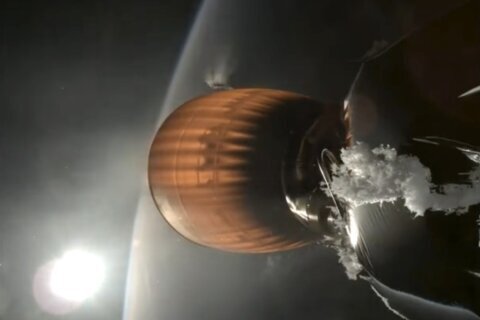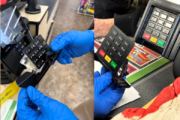WASHINGTON — Look! Up in the sky. It’s a rocket.
On Sunday night, NASA Wallops Island is scheduled to launch a rocket that will be visible in the D.C. area. According to NASA, “The window for a NASA Terrier-Improved Malemute sounding rocket launch to test a new ampoule ejection system designed to support studies of the ionosphere and aurora opens June 11 and runs through June 18. Lift-off for a June 11 launch is scheduled between 9:04 and 9:19 p.m. EDT.”
The multi-canister ampoule ejection system will release blue-green and red vapor to form artificial clouds between 4 and 5.5 minutes after launch. These blue-green and red artificial clouds may be visible along the mid-Atlantic coastline, from New York to North Carolina.
The NASA Visitor Center at Wallops will open at 8 p.m. on launch day for viewing the flight. Check NASA’s website for updates.
Third gravitational wave discovered
Did you feel it? The fabric of space surrounding our planet was disturbed on Jan. 4, 2017 by the passage of a gravitational wave caused by two colliding black holes. You wouldn’t feel these waves as the displacement of spacetime is about 1/1000th the width of an atomic nucleus — very small indeed. This event happened twice as far away, billions of light years from us, than the previous two events.
I participated in the May 31 teleconference to learn more about the event from scientists who are part of the 1,000-member team involved in the discovery.
The Laser Interferometer Gravitational-wave Observatory, or LIGO, named the event GW170104 and described it as follows:
“The newfound black hole, formed by the merger, has a mass about 49 times that of our sun. This fills in a gap between the masses of the two merged black holes detected previously by LIGO, with solar masses of 62 (first detection) and 21 (second detection).”
LIGO’s ongoing observations are carried out by twin detectors: one in Hanford, Washington, which I visited just last month, and the other in Livingston, Louisiana, operated by Caltech and MIT with funding from the National Science Foundation.
One thing about LIGO that really excites me and what I asked the teleconference team about is the discovery of colliding neutron stars. It is expected that LIGO will eventually detect this type of event but they just can’t predict when. The good news is that LIGO is capable of doing so.
LIGO’s current observing run will end in August. What further discoveries await us?
NASA mission is headed to a star
NASA is launching a mission to a star that will actually fly through its atmosphere and come as close as 3.9 million miles from its surface. The star is none other than our sun.
The Parker Solar Probe is scheduled for launch summer 2018 by a Delta IV Heavy and is being built and managed by Johns Hopkins University Applied Physics Laboratory in Laurel, Maryland. The mission is part of NASA’s Living With a Star program to explore aspects of the sun-Earth system that directly affects life and society. The LWS program is managed by the agency’s Goddard Space Flight Center in Greenbelt, Maryland, for NASA’s Science Mission Directorate in D.C.
Originally named Solar Probe Plus, the Parker Solar Probe is the first time NASA has named a spacecraft for a living individual, astrophysicist Eugene Parker.
As explained by a NASA statement: “Parker’s work forms the basis for much of our understanding about how stars interact with the worlds that orbit them.” In the 1950s, Parker proposed a number of concepts about how stars — including the sun — give off energy. He called this cascade of energy the solar wind; and he described an entire complex system of plasmas, magnetic fields and energetic particles that make up this phenomenon.
Parker also theorized an explanation for the superheated solar atmosphere, the corona, which is — contrary to what was expected by physics laws — hotter than the surface of the sun itself.
Parker Solar Probe is designed to learn more about the sun from the closest we have ever been to this star. The probe will have to endure temperatures of 2,500 degrees Fahrenheit and intense radiation. The spacecraft will be thermally protected by a 4.5-inch carbon-composite shield and will be hardened against radiation. At closest approach, the spacecraft will be hurtling around the sun at approximately 450,000 miles per hour, which is fast enough to get from Philadelphia to D.C. in one second.
Learning about the sun is vital to us. Consider this from the Parker Solar Probe webpage:
“One recent study by the National Academy of Sciences estimated that without advance warning, a huge solar event could cause two trillion dollars in damage in the U.S. alone, and the eastern seaboard of the U.S. could be without power for a year. In order to unlock the mysteries of the corona, but also to protect a society that is increasingly dependent on technology from the threats of space weather, we will send Parker Solar Probe to touch the sun.”
New astronaut class of 2017
Meet the newest class of astronaut candidates. The 12 people will report to NASA in August and begin rigorous training to become full-fledged astronauts. The five women and seven men came from a wide, variety of backgrounds and were chosen from NASA’s largest applicant pool ever of 18,300.
Follow Greg’s daily blog www.whatsupthespaceplace.com to keep up with the latest news in astronomy and space exploration. You can email Greg at skyguyinva@gmail.com.







